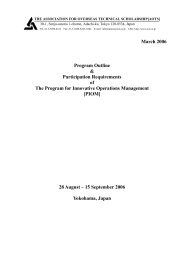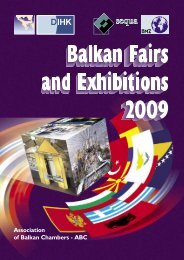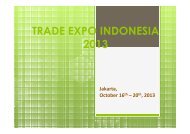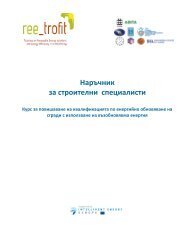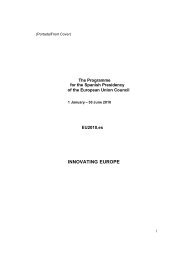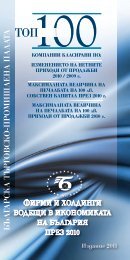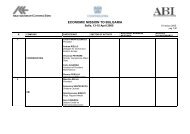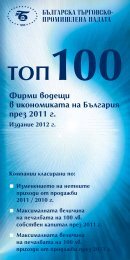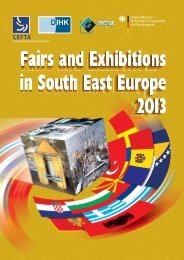Analysis of the Operation and Financial Condition of the Enterprise
Analysis of the Operation and Financial Condition of the Enterprise
Analysis of the Operation and Financial Condition of the Enterprise
You also want an ePaper? Increase the reach of your titles
YUMPU automatically turns print PDFs into web optimized ePapers that Google loves.
<strong>Analysis</strong> <strong>of</strong> <strong>the</strong> <strong>Operation</strong> <strong>and</strong> <strong>Financial</strong> <strong>Condition</strong> <strong>of</strong> <strong>the</strong> <strong>Enterprise</strong>Gross pr<strong>of</strong>it is <strong>the</strong> excess <strong>of</strong> net turnover over <strong>the</strong> production cost <strong>of</strong> <strong>the</strong> goodssold. It is calculated as follows:Gross pr<strong>of</strong>itGross pr<strong>of</strong>it margin 100 %(4.27.)Net turnoverAn increase or a decrease in <strong>the</strong> gross pr<strong>of</strong>it is influenced by two factors: changesin net turnover <strong>and</strong> changes in <strong>the</strong> production cost <strong>of</strong> goods sold. On <strong>the</strong> o<strong>the</strong>r h<strong>and</strong>, <strong>the</strong>changes in <strong>the</strong>se two factors are interrelated with <strong>the</strong> scope <strong>of</strong> production, price per unit <strong>of</strong>output <strong>and</strong> prime cost per unit <strong>of</strong> output.Economic or rates <strong>of</strong> return on assets are <strong>the</strong> most commonly used pr<strong>of</strong>itabilitymeasures <strong>and</strong> <strong>the</strong>y are calculated in relation to total assets. Return <strong>of</strong> assets is usuallycalculated according to <strong>the</strong> following formula:Earningsbeforeinterest <strong>and</strong> taxReturn on assets 100%(4.28.)Averagevalue<strong>of</strong> assetsReturn <strong>of</strong> assets is applied to assess, how efficiently an enterprise has employedits resources (assets) in generation <strong>of</strong> its income. This measure illustrates <strong>the</strong>competitiveness <strong>of</strong> an enterprise. The level <strong>of</strong> competitiveness is determined by comparing<strong>the</strong> assets <strong>of</strong> any given enterprise with <strong>the</strong> industry average figure.The level <strong>of</strong> this value depends on <strong>the</strong> specifics <strong>of</strong> <strong>the</strong> industry in which anenterprise operates. The rate <strong>of</strong> return on assets is considerably higher (compared to <strong>the</strong>industry average figure) in enterprises operating in businesses where <strong>the</strong>re is a wide use <strong>of</strong>manual labour, while in businesses involving high levels <strong>of</strong> capital it is low.Return on assets can be increased by raising <strong>the</strong> sales price. This is, however, adifficult task in a free market conditions. Only those enterprises that dictate <strong>the</strong> prices in<strong>the</strong> market can afford raising its sales prices <strong>and</strong>, thus increase <strong>the</strong>ir return on assets. Alsoenterprises dealing in manufacturing <strong>of</strong> some unique products can afford to increase <strong>the</strong>irsales prices after which <strong>the</strong> dem<strong>and</strong> is not dependent on <strong>the</strong> price as <strong>the</strong> product itself ismore important than <strong>the</strong> price. Problems may occur for some enterprises due to an increasein <strong>the</strong> price per unit <strong>of</strong> goods, because <strong>the</strong>n <strong>the</strong> net turnover will decline <strong>and</strong> an enterprisecan become uncompetitive.The most commonly used measures <strong>of</strong> financial pr<strong>of</strong>itability are <strong>the</strong> return on total capital<strong>and</strong> return on equity capital.Return on total capital shows what <strong>the</strong> amount <strong>of</strong> pr<strong>of</strong>it could be if all <strong>of</strong> <strong>the</strong> capitalemployed would be equity capital. However, because it cannot be detected, what share <strong>of</strong>pr<strong>of</strong>it has been gained by disbursement <strong>of</strong> <strong>the</strong> debt capital, only <strong>the</strong> interest payable on use<strong>of</strong> external capital can be seen. It is estimated according to <strong>the</strong> following formula:Return on total capitalAnnual pr<strong>of</strong>it Interest paid 100 % (4.29.)Total capitalThe average value <strong>of</strong> <strong>the</strong> total capital is used as <strong>the</strong> value for denominator. This isbecause <strong>the</strong> pr<strong>of</strong>it has been made over <strong>the</strong> entire reporting period, while <strong>the</strong> total capital isshown as <strong>of</strong> <strong>the</strong> final day <strong>of</strong> <strong>the</strong> period. This means, that within <strong>the</strong> period an enterprisemay as well have acquired or lost some capital. Thus <strong>the</strong> pr<strong>of</strong>it/loss figure for <strong>the</strong> reporting83



